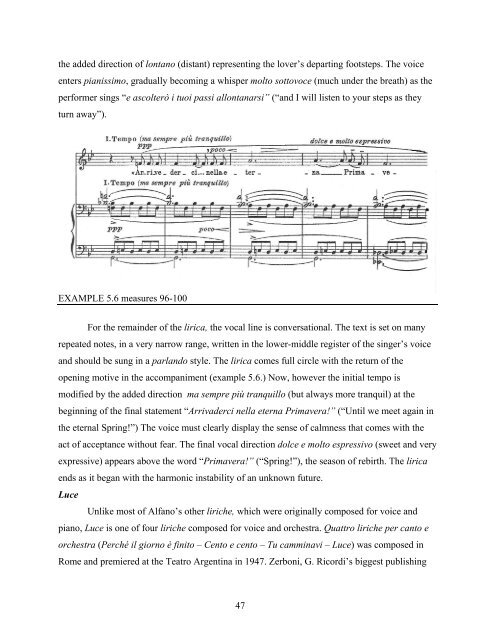Allesandro Longo complied the most complete edition of Domenico ...
Allesandro Longo complied the most complete edition of Domenico ...
Allesandro Longo complied the most complete edition of Domenico ...
Create successful ePaper yourself
Turn your PDF publications into a flip-book with our unique Google optimized e-Paper software.
<strong>the</strong> added direction <strong>of</strong> lontano (distant) representing <strong>the</strong> lover’s departing footsteps. The voice<br />
enters pianissimo, gradually becoming a whisper molto sottovoce (much under <strong>the</strong> breath) as <strong>the</strong><br />
performer sings “e ascolterò i tuoi passi allontanarsi” (“and I will listen to your steps as <strong>the</strong>y<br />
turn away”).<br />
EXAMPLE 5.6 measures 96-100<br />
For <strong>the</strong> remainder <strong>of</strong> <strong>the</strong> lirica, <strong>the</strong> vocal line is conversational. The text is set on many<br />
repeated notes, in a very narrow range, written in <strong>the</strong> lower-middle register <strong>of</strong> <strong>the</strong> singer’s voice<br />
and should be sung in a parlando style. The lirica comes full circle with <strong>the</strong> return <strong>of</strong> <strong>the</strong><br />
opening motive in <strong>the</strong> accompaniment (example 5.6.) Now, however <strong>the</strong> initial tempo is<br />
modified by <strong>the</strong> added direction ma sempre più tranquillo (but always more tranquil) at <strong>the</strong><br />
beginning <strong>of</strong> <strong>the</strong> final statement “Arrivaderci nella eterna Primavera!” (“Until we meet again in<br />
<strong>the</strong> eternal Spring!”) The voice must clearly display <strong>the</strong> sense <strong>of</strong> calmness that comes with <strong>the</strong><br />
act <strong>of</strong> acceptance without fear. The final vocal direction dolce e molto espressivo (sweet and very<br />
expressive) appears above <strong>the</strong> word “Primavera!” (“Spring!”), <strong>the</strong> season <strong>of</strong> rebirth. The lirica<br />
ends as it began with <strong>the</strong> harmonic instability <strong>of</strong> an unknown future.<br />
Luce<br />
Unlike <strong>most</strong> <strong>of</strong> Alfano’s o<strong>the</strong>r liriche, which were originally composed for voice and<br />
piano, Luce is one <strong>of</strong> four liriche composed for voice and orchestra. Quattro liriche per canto e<br />
orchestra (Perché il giorno è finito – Cento e cento – Tu camminavi – Luce) was composed in<br />
Rome and premiered at <strong>the</strong> Teatro Argentina in 1947. Zerboni, G. Ricordi’s biggest publishing<br />
47
















